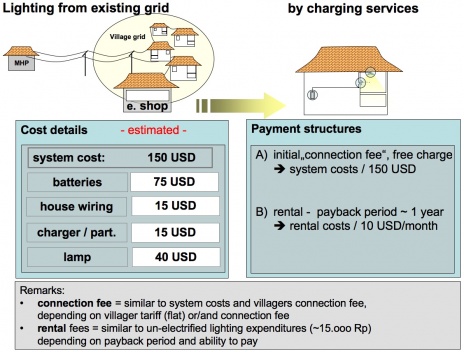Knowledge fuels change - Support energypedia!
For over 10 years, energypedia has been connecting energy experts around the world — helping them share knowledge, learn from each other, and accelerate the global energy transition.
Today, we ask for your support to keep this platform free and accessible to all.
Even a small contribution makes a big difference! If just 10–20% of our 60,000+ monthly visitors donated the equivalent of a cup of coffee — €5 — Energypedia would be fully funded for a whole year.
Is the knowledge you’ve gained through Energypedia this year worth €5 or more?
Your donation keeps the platform running, helps us create new knowledge products, and contributes directly to achieving SDG 7.
Thank you for your support, your donation, big or small, truly matters!
Difference between revisions of "Hydro Battery Charging Station"
***** (***** | *****) |
***** (***** | *****) |
||
| Line 19: | Line 19: | ||
== Description of the battery charging system in Mozambique: == | == Description of the battery charging system in Mozambique: == | ||
| − | AMES- | + | Acceso Modernos os Servicios de Energia in Mozambique (AMES-M) includes battery charging statons in the project activities. |
| − | + | The aim is to offer a solution to remote houses which are too far from a micro or pico hydro site to benefit from a local mini grid. These houses then have access to energy by acquiring a battery kit (battery+charge controller+inverter). | |
| − | + | Some villagers already have experiences using a battery and an inverter for domestic devices like Cellphone charger, TV, DVD players and lighting to a limited extent. It has been observed that they use second hand car batteries, poor quality inverters and incandescent bulbs. For charging the batteries, they use sencond hand solar panels conected directly to a second hand car battery. | |
| − | + | Currently the evaluation of the next potencial sites is being done: | |
| + | |||
| + | -Mouha | ||
| + | |||
| + | -Chimukono<br><br> | ||
== Description of the battery charging that is planned for Burundi (Solar power): == | == Description of the battery charging that is planned for Burundi (Solar power): == | ||
Revision as of 13:34, 2 December 2011
Battery Charging with Electricity from Hydro Power:
Mhp delivers constant power output as it uses a constant water flow. There is no need to store energy if there is a power grid connected which is able to absorb the mhp's output.
Island grids, or isolated grids in remote regions do not have a constant power demand. During periods of excess energy production Battery charging may be an option. So households which are located away from the power lines can get battery powered lighting or Radio/TV.
New techniques like (W)LED-lighting or LED-TV have reduced energy consumption. Therefore its powering by battery becomes more feasible. Rechargeable battery, LED-equipment and the required charging services have substantial costs. As such services are scale able from a "single lamp" up to "24 hr TV-entertainment" it may be financial stabile. Robust equipment, proper maintenance and social acceptance are preconditions to establish such an "energy kiosk".
A Master Thesis on "Design of a Micro hydro powered charging System for rural village electrification" by Sebastian Hermann done in Indonesia, 2006 can be found here: Part 1, Part 2, Part 3, Part 4
Experience from EnDev projects:
Description of the battery charging system in Mozambique:
Acceso Modernos os Servicios de Energia in Mozambique (AMES-M) includes battery charging statons in the project activities.
The aim is to offer a solution to remote houses which are too far from a micro or pico hydro site to benefit from a local mini grid. These houses then have access to energy by acquiring a battery kit (battery+charge controller+inverter).
Some villagers already have experiences using a battery and an inverter for domestic devices like Cellphone charger, TV, DVD players and lighting to a limited extent. It has been observed that they use second hand car batteries, poor quality inverters and incandescent bulbs. For charging the batteries, they use sencond hand solar panels conected directly to a second hand car battery.
Currently the evaluation of the next potencial sites is being done:
-Mouha
-Chimukono
Description of the battery charging that is planned for Burundi (Solar power):




















